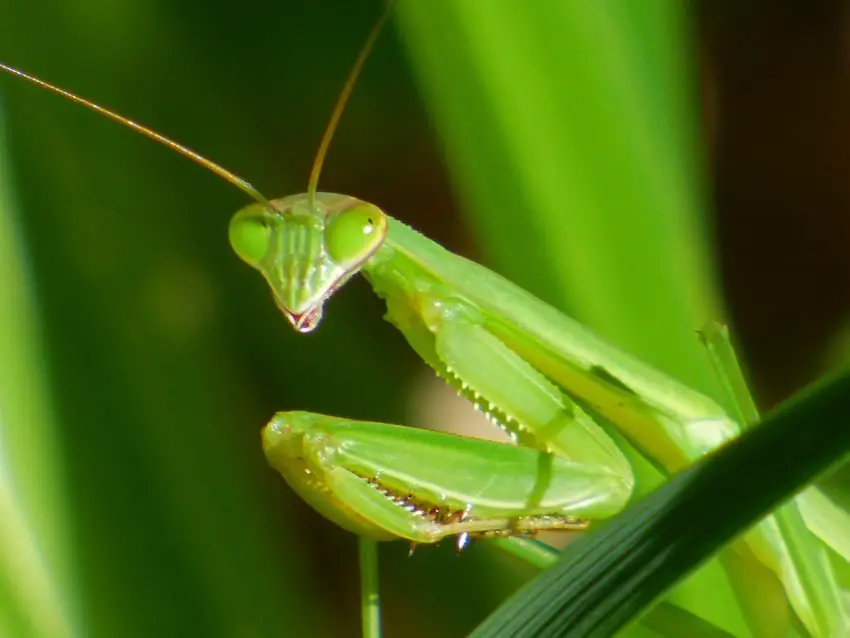As we delve into the fascinating world of praying mantis, we find ourselves pondering a curious question: do praying mantis sleep? If so, how do praying mantis sleep? Like many creatures in the animal kingdom, praying mantis also exhibit intriguing behavioral patterns, leaving us to wonder about their restful habits. In this exploration, we will unravel the mystery surrounding whether praying mantis takes moments to slumber or remain ever-vigilant in their waking state.

How do praying mantis sleep?
Praying mantis has unique sleeping habits that differ from those of mammals like us. Unlike humans who enter a deep sleep state, praying mantis experiences a lighter form of sleep known as “torpor.” During torpor, their metabolic rate decreases, and they become less active, conserving energy while still maintaining a level of awareness. It is similar to hibernation in other living creatures, but do praying mantis hibernate?
During their resting period, praying mantis might exhibit some unique behaviors. Some species adopt a posture known as “roosting,” where they tuck their legs and antennas close to their bodies, making themselves appear smaller and less noticeable to potential predators.
Do praying mantis sleep upside down?
Yes, praying mantis can sleep upside down. These agile insects are known for their remarkable ability to adopt various sleeping positions, including upside down. They have specialized legs that allow them to cling to surfaces in different orientations, giving them the flexibility to rest in almost any position.
When praying mantis sleep upside down, they use their strong front legs to hold on to the surface they are resting on. Their unique grasping ability enables them to stay securely attached while they are in their torpor state, conserving energy and remaining hidden from potential predators.
Where do praying mantis sleep?
These resourceful insects adapt to various hiding spots that offer protection and convenience during their resting periods. Their diverse choice of sleeping locations showcases their exceptional ability to blend into different environments. So, where do praying mantis sleep?
- On Branches or Leaves: Praying mantis often rest on plant branches or leaves, using their camouflage to stay hidden from predators.
- Amongst Foliage: Dense foliage provides a cozy resting spot for praying mantis, where they can cling to leaves and remain inconspicuous.
- Under Eaves or Overhangs: In urban areas, praying mantis may seek shelter under eaves or roof overhangs to sleep.
- On Window Frames: It’s not uncommon to find praying mantis resting on window frames or sills, taking advantage of sheltered spots.
- In Garden Structures: Praying mantis may rest on garden structures like trellises, fences, or stakes, utilizing them as perches.
- In Vegetation: Ground-dwelling species of praying mantis may choose to rest within low-lying vegetation, such as grass or shrubs.
- On Man-Made Objects: Sometimes, praying mantis can be found resting on man-made objects like statues, walls, or outdoor furniture.

When do praying mantis sleep?
Praying mantis is predominantly active during the daytime, making them diurnal insects. They are skilled hunters and use their excellent vision and agility to capture prey during daylight hours. However, like most creatures, praying mantis needs rest and downtime to conserve energy.
Praying mantis typically sleeps at night, choosing the cover of darkness to rest and rejuvenate. During the nighttime, they become less active and enter a state of reduced activity called “torpor.” It’s important to note that the sleeping patterns of praying mantis can be influenced by factors like temperature, food availability, and their species.
Conclusion
In conclusion, the sleeping habits of praying mantis reveal fascinating insights into their adaptability and survival strategies. As diurnal insects, they actively hunt during the day and seek rest at night, entering a lighter state of sleep known as torpor. Their exceptional ability to sleep upside down and rest in various positions highlights their agility and specialized legs.
Throughout the night, praying mantis finds secure spots, like branches or leaves, where their camouflage keeps them hidden from predators. Their restful periods play a vital role in conserving energy and ensuring they are ready for another day of active hunting.
If you found this article interesting, don’t hesitate to share it on social media!
May interest you
Why Do Praying Mantis Sway? 6 Reasons Behind Mantis Dance
Are praying mantis poisonous?
One prevalent question that surrounds these enigmatic insects is “are praying mantis poisonous?”. In this article, we will delve into the world of praying mantises to uncover the facts behind…